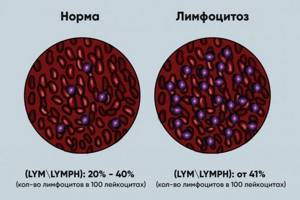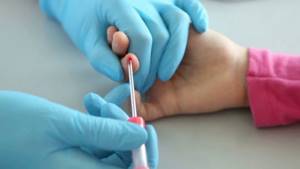Why do lymphocytes increase in a child’s blood?
What are lymphocytes
Lymphocytes are a type of white blood cell that are one of the main cells of the immune system.
They are formed in the bone marrow and are found in the blood and lymphoid tissue. Among these cells, several types are distinguished. They work together to protect the body from the introduction of foreign agents such as viruses and bacteria that can threaten human health. What types of lymphocytes are there? Among the lymphocytes, T-, B- and NK-lymphocytes are distinguished.
B lymphocytes are capable of producing antibodies in response to an encounter with a foreign antigen that other cells present to them. Some of them have a memory for foreign agents for many years. That is, if the body encounters such an enemy again, they meet it fully armed. It is this property of the immune system that vaccination is based on.
T lymphocytes are involved in activating and inhibiting the immune system. Their responsibilities include destroying the antigen. Depending on their specific “position”, T-killers, T-suppressors, and T-helpers . They supervise and direct military operations.
NK lymphocytes (natural killer cells) are capable of destroying cells that differ in structure from normal ones, including cancer cells.
The normal level of lymphocytes in the blood of children
Standards may vary among different laboratories that performed the analysis.
As a rule, insignificant. A distinction is made between the absolute value of lymphocytes (the number of cells in units) and the relative value (the number of lymphocytes indicated as a percentage relative to other types of leukocytes). Normal lymphocyte values in children:
- newborns – 2,0-7,3*10*9, 15-35%;
- 0-7 days life – 2,8 – 9,1*10*9, 22-55%;
- up to 1 month – 3,0-13,5 *10*9, 45-70%;
- 1-6 months – 4,0-10,05*10*9, 45-70%;
- 6-12 months – 4,0-10,5*10*9, 45-70%;
- 1-2 years – 1,5 – 9,5 *10*9, 37-60%;
- 2-6 years – 1,5 – 9,5 *10*9, 33-55%;
- 6-12 years – 1,5-7,0 *10*9, 30-50%;
- over 12 years old – 1,1 – 6,5 *10*9, 19-37%.
Normally, children have their own age-related characteristics of the blood composition - physiological cross-sections of the leukocyte formula. At the time of birth, they have leukocytosis with a predominance of neutrophils, by the 5-7th day of life the number of neutrophils and lymphocytes is comparable (the first physiological crossover), and then lymphocytes begin to predominate until the age of 5 years (the second physiological crossover).
From 4-5 years, the number of lymphocytes gradually decreases and reaches adult levels. These features must be remembered so as not to regard the age norm as a pathology!
Main causes of lymphocytosis
- Physiological leukocytosis from 4 months to 4 years of life.
- Infectious leukocytosis – in acute and chronic infectious processes. Acute ones include an increase in lymphocytes in acute respiratory viral infections (influenza, parainfluenza, adenovirus, RS virus and others), measles, chickenpox, infectious mononucleosis, cytomegalovirus infection, mumps, toxoplasmosis. Among chronic infectious processes, tuberculosis is distinguished.
- Lymphocytes may also be elevated in a child due to endocrine disorders - with excessive production of thyroid hormones - with hyperthyroidism.
- Oncological diseases – acute lymphoblastic leukemia, lymphomas, chronic lymphoblastic leukemia.
- Familial lymphocytosis.
- Autoimmune diseases , including graft-versus-host rejection.
- Post-transfusion syndrome - after transfusion of blood components.
Causes of lymphocytosis
Physiological conditions
The most striking example is physiological lymphocytosis in children under 4-5 years of age. The reason for this phenomenon is associated with age-related changes in the child’s immune system. From the 7th day of life in children, an active increase in the number of lymphocytes begins (up to 55-60%) and a decrease in neutrophils (the first cross-over of the leukocyte formula). Then, by the age of 4, lymphocytes return to the same levels as in adults (up to 40%), and neutrophils, on the contrary, increase (second crossover). Pathological lymphocytosis in children should be considered figures greater than 60%.
Separately, short-term lymphocytosis is distinguished, not associated with any disease. Among these causes of lymphocytosis:
- Stress
. - Nutritional factors
: fasting, following a vegetarian diet. - Use of medications
: phenytoin, para-aminosalicylic acid, narcotic analgesics.
Viral infections
Lymphocytes are the main “weapon” of the immune system against viruses. They produce special antibodies (immunoglobulins), which, by binding to the virus, prevent its penetration into cells. Subsequently, the viral particles undergo phagocytosis. Another mechanism of antiviral immunity is the destruction of cells infected with viral DNA or RNA by triggering programmed cell death (apoptosis). In a similar way, lymphocytes fight certain bacteria and intracellular parasites (Toxoplasma).
- Acute viral infections
. The most common causes of lymphocytosis in children are infectious diseases such as measles, rubella, and chicken pox; in adults - influenza, ARVI. Typically, lymphocytosis is moderate, it occurs abruptly, reaches a maximum parallel to the height of the disease, then quickly returns to normal values as the symptoms resolve. - Infectious mononucleosis
. A specific viral infection in children is infectious mononucleosis caused by the Epstein-Barr virus. In infectious mononucleosis, lymphocytosis is more persistent and can persist for several weeks or months. Sometimes the virus persists for years and can cause chronic fatigue syndrome.
In addition to quantitative changes, viral infections are considered to be the cause of the appearance of atypical mononuclear cells (virocytes) - lymphocytes with different shapes, altered nuclear structure, and basophilic cytoplasm. They are present in small quantities (less than 10%) during any viral infections. A higher concentration of such cells (more than 10%) indicates infectious mononucleosis.
Bacterial infections
In adults, one of the common causes of lymphocytosis is bacterial infections with a chronic course, accompanied by the formation of specific epithelioid granulomas (tuberculosis, brucellosis, syphilis). Less commonly, the cause of lymphocytosis in adults is typhoid diseases (typhoid, typhus, paratyphoid). Whooping cough is considered the only acute bacterial infection that causes lymphocytosis in children.
Basically, slight lymphocytosis is observed, and almost always relative, against the background of general leukopenia. Due to the chronic course of the disease, lymphocytosis can persist indefinitely (months, years), increasing during periods of exacerbation. In tuberculosis, lymphocytosis indicates a benign course and is considered a predictor of a favorable outcome.

Lymphocytosis: norm and pathology
Malignant blood diseases
Myeloproliferative and lymphoproliferative diseases are recognized as the most dangerous cause of lymphocytosis in adults and children. In such cases, lymphocytosis is caused by the proliferation of tumor clones of lymphatic tissue or malignant transformation of hematopoietic cells in the bone marrow. In adults, chronic leukemia and non-Hodgkin's lymphomas (lymphosarcoma) are mainly observed. Lymphogranulomatosis (Hodgkin's lymphoma) is more common in children. Lymphocytosis reaches very high numbers (up to 70-90%).
The increase in lymphocytosis occurs gradually: the maximum value is reached after several years, and decreases slowly, only under the influence of chemotherapy courses. A quick return to normal levels is possible only with a bone marrow transplant. In addition to lymphocytosis, signs such as a simultaneous increase in eosinophils and basophils (basophil-eosinophil association), the presence of a large number of blasts, intermediate forms (prolymphocytes) are noted.
Endocrine disorders
In some cases, the cause of lymphocytosis is diseases of the endocrine organs. The exact mechanism of this phenomenon has not yet been fully established. A moderate degree of lymphocytosis often develops simultaneously with an increase in the concentration of eosinophils. In adults, this picture is observed with acromegaly, thyrotoxicosis, and adrenal insufficiency. In children, a common cause is congenital dysfunction of the gonads. Lymphocytosis quickly regresses after hormone replacement therapy is prescribed.
Other reasons
- Rheumatological pathologies
: rheumatoid arthritis, acute rheumatic fever, systemic lupus erythematosus. - Blood diseases
: aplastic anemia, B12 folate deficiency anemia, post-transfusion syndrome. - Parasitic infestations
: malaria, Chagas disease, schistosomiasis. - Allergic reactions
: bronchial asthma.
How can you suspect lymphocytosis, or When will the doctor send you for analysis?
It is impossible to suspect a specific condition when lymphocytes in a child’s blood are elevated. We can only assume that the child has a disease in which we will see an increase in lymphocytes in a general blood test.
For viral infections, such signs will be cough, runny nose, fever, conjunctivitis, and enlarged peripheral lymph nodes. Such conditions can be complicated by the development of respiratory failure (the appearance of shortness of breath, the participation of auxiliary muscles in breathing), especially in young children.
Symptoms of hanging hemoglobin in a child
Symptoms of elevated hemoglobin will persist for a long time. As a rule, the child exhibits the following signs:
- severe drowsiness, weakness, fatigue;
- poor appetite;
- dizziness and headaches, fainting;
- problems with vision and hearing;
- the appearance of bruises even with slight palpation;
- arrhythmia, tachycardia;
- blue or pale fingertips and lips, numbness.
In addition to these symptoms of increased hemoglobin, blood clots can also be detected in the stool. Some people experience itching after swimming in the water. Problems with the urinary system may also occur, and sudden weight loss may begin.
What analysis reveals an increase in lymphocytes?
Lymphocytosis is diagnosed through a routine complete blood count. It always indicates two values of lymphocytes - absolute and relative as a percentage. Lymphocytes are designated in a general blood test as LYM; when indicated as a percentage, the letter “L” may simply appear.
Most often, this analysis is enough to judge the viral nature of the disease, but if there is a suspicion that the child has an oncological process, then more specific examinations are prescribed.
This includes bone marrow puncture and lymph node biopsy .
In addition, to detect the virus, a nasal swab can be prescribed for RIF (immunofluorescence reaction) in acute respiratory diseases. This analysis is most informative only in the first 3 days from the onset of the disease.
If infectious mononucleosis is suspected, blood from a vein is tested for Abshane-Barr virus, cytomegalovirus using enzyme-linked immunosorbent assay (ELISA) or PCR (polymerase chain reaction).
Ancillary diagnostic methods include: ultrasound of lymph nodes, ultrasound of the abdominal cavity, ultrasound of the thyroid gland.
In controversial and ambiguous cases, a biochemical blood test can be performed to determine specific markers of inflammation, such as, for example, CRP (C-reactive protein).

Do I need to prepare for the analysis?
To obtain a more reliable picture of a blood test, preparation is necessary for its implementation.
Mode
Before the analysis, it is not recommended to eat food 12 hours before the test (in children under 1 year, several hours).
Medications
Some medications can distort the blood picture. Such drugs include glucocorticoid hormones, chemotherapeutic drugs, cytostatics, and neuroleptics.
What can distort the results
Stress, heavy physical activity, food, and taking certain medications can distort the results.

Approaches to the treatment of conditions in which lymphocytes in the blood of a child increase
Treatment of children with lymphocytosis depends on the cause that caused such changes in the general blood test. If we are talking about a viral infection, then treatment in most cases is symptomatic. That is, at a high temperature, antipyretic drugs are given, in the presence of rhinitis, nasal sanitation is prescribed, in the presence of a cough, antitussive drugs and/or inhalation therapy, and so on.
Be sure to prescribe plenty of fluids and bed rest for the febrile period.
To date, there are no antiviral drugs that have undergone multicenter randomized studies indicating their effectiveness!
Therefore, the prescription of these drugs, which have flooded the entire pharmacy chain with beautiful advertising and promises of a quick recovery, is not justified. The only exceptions are drugs such as oseltamivir (used for influenza), acyclovir (prescribed for herpes infections and in some cases for chickenpox) and ganciclovir and its derivatives (for cytomegalovirus infection). It should be mentioned that the currently popular homeopathic medicines in the treatment of viral infections also have no effectiveness, that is, they do not work.
For some viral (measles, rubella, hepatitis B and A, mumps) infections, the only effective means of prevention today remains vaccination.
For the development of these diseases, etiotropic treatment, that is, acting on a specific pathogen, is not available anywhere in the world today!

Symptoms
Elevated lymphocytes in a child are accompanied by the following symptoms:
- dyspnea;
- deterioration of general condition;
- fever;
- lethargy;
- sleep disturbance;
- the appearance of a rash;
- increase in body temperature.
The child will become capricious and his lymph nodes will enlarge. Against the background of the disease, the spleen and liver may increase in size.
Take into account! After recovery, the level of lymphocytes does not stabilize immediately; this may take from several weeks to several months. The process of lowering the level of lymphocytes is gradual.
When to see a doctor
If you have any of the above diseases and symptoms, you should consult a doctor. The doctor will assess the situation, taking into account the baby's age. If a child has elevated lymphocytes, then blood donation is prescribed to check the level of monocytes. If it is exceeded, this is a sign of a viral infection.
An immunologist-infectious disease specialist at Meditsina JSC (academician Roitberg’s clinic) will determine the cause and eliminate it in a short time, carrying out a suitable diagnosis. The clinic is located in the center of Moscow.
Diagnostics
Diagnosis depends on the cause, on what is affecting the child’s body that led to an increased level of white blood cells. The main diagnostic methods include computed tomography or ultrasound. A number of laboratory tests are also prescribed, and the child is required to undergo a blood test. Diagnostics allows you to draw conclusions, determine the level of danger and risks, and prescribe effective treatment (depending on what was the cause).
Prevention of lymphocytosis
Prevention of lymphocytosis consists primarily in the prevention of diseases that cause an increase in lymphocytes. Most often, lymphocytosis occurs during viral infections, so by following simple rules of prevention, you can minimize the risk of a child getting sick.
These include:
- rational nutrition and feeding of the child;
- timely vaccination of the child;
- avoiding contact with infectious patients;
- walks in the open air;
- periodic intake of vitamin therapy courses;
- choosing clothes for the child that suit the weather conditions (avoid overheating and hypothermia of the baby).
What if there are few lymphocytes?
If a child has few lymphocytes in the blood, this may also be a sign of the presence of a serious pathology and this condition is called lymphopenia.
The reasons for such changes in the blood test may be immunodeficiencies (X-linked agammaglobulinemia, combined immunodeficiencies), HIV infection, and such a blood picture can also be seen after treatment with glucocorticoid hormones, after radiation therapy.
We often see a low content of lymphocytes and a lot of neutrophils in any bacterial infections. Also, low values of lymphocytes can occur under stress, poor nutrition, and physical activity.
Monocytes
Monocytes are cells of the immune system that are among the first to respond to the penetration of aggressors into the body. If the forces of local immunity could not contain the attack of bacteria, fungi or viruses, then it is monocytes that are the first to rush to protect health.
Monocytes are formed in the red bone marrow and released into the blood. There they begin to actively function, but this does not last long, only 2-3 days. Then, using their ability to move, they move beyond the vessels through special small pores between the cells and penetrate into the tissue. There, monocytes slightly change their structure and turn into macrophages - more effective phagocytes.










